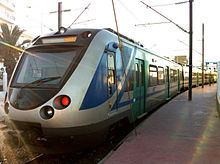Sousse
[1][2][3] Sousse is in the center of Tunisia, on the Tunisian Sahel coast and on the Mediterranean Sea bordering the east of the country.
Its establishment (at a river mouth about 9.7 km or 6 mi north of old Sousse)[10][11] preceded Carthage's[12] but, like other western Phoenician colonies, it became part of the Carthaginian Empire[9] following Nebuchadnezzar II's long siege of Tyre in the 580s and 570s BC.
Its native sons included the jurist Salvius Julianus, the emperor Clodius Albinus, and numerous Christian saints.
The Byzantine Empire reconquered the town in 534 during the Vandal War and engaged in a public works program that included new fortifications and churches.
According to a 1987 ICOMOS report, Uqba ibn Nafi's siege and capture of the city resulted in its almost complete destruction, such that no monument of Hadrumetum "subsists in situ".
After the Byzantine city of Melite (modern Mdina on Malta) was captured by the Aghlabids in 870, marble from its churches was used to build the Ribat.
[14] A soaring structure that combined the purposes of a minaret and a watch tower, it remains in outstanding condition and draws visitors from around the world.
Susa was briefly occupied by Norman Sicily in the 12th century; it fell to the Ottoman Empire in the 16th; and it was bombarded by a French and Venetian fleet in the 18th.
[5] Between 1896 and 1911, railways were built connecting Sousse with Tunis, Kairouan, Sfax, Mahdia, Moknin, and Henshir Suwatir.
[citation needed] The first developments outside the medina walls were begun during this period, but they were home to a relatively small number of people until after the Second World War.
With a population of about 200,000, Sousse retains a medieval heart of narrow, twisted streets, a kasbah and medina, its ribat fortress and long wall on the Mediterranean.
Sousse was the site of the chess interzonal in 1967, made famous when American Grandmaster Bobby Fischer withdrew from the tournament even though he was in first place at the time.
[16] On 26 June 2015, a lone gunman, Seifeddine Rezgui Yacoubi, opened fire on tourists sunbathing on a beach near the Riu Imperial Marhaba and Soviva hotels, killing 38 and wounding 39, before being shot dead by the police.
Sousse's most important economic activity takes place in the tertiary sector, which employs over 50% of the city's workforce and includes administration, education, healthcare, trade, communications, and banking.
[5] Not far behind is the secondary sector, which employs another 45% of the city's workers and includes industries like textiles and leather, construction, chemicals, electronics, and mechanical and electrical components.
Some 1,200,000 visitors come every year to enjoy its hotels and restaurants, nightclubs, casinos, beaches, and sports facilities.
Sousse is well-connected with the main Tunisian Railways network, having non-electrified lines to Tunis (since 1899), Sfax (since 1911), and Kasserine (since 2004) with diesel multiple unit and locomotive-driven trains.
Urban transit in Sousse is served by routes of articulated and conventional buses, blue-strip louages, and cheap taxis.
UNESCO declared the medina of Sousse a World Heritage Site in 1988, citing among various things its preservation from modern development.
[19] The architecture, although modern and dazzlingly white, has been modeled on the more traditional buildings in Tunisia, complete with narrow streets and arches.
Located at the entrance to the medina, it was erected by the Aghlabid sovereign Aboul Abbas I (841–856) in 850–851, almost thirty years after the construction of the Ribat of Sousse.









